
Androcalva fraseri, commonly known as blackfellow's hemp or brush kurrajong, is a species of flowering plant in the family Malvaceae and is endemic to eastern Australia. It is a small tree or shrub that forms suckers and has egg-shaped or lance-shaped leaves with serrated edges, and clusters of 13 to 21 white flowers.
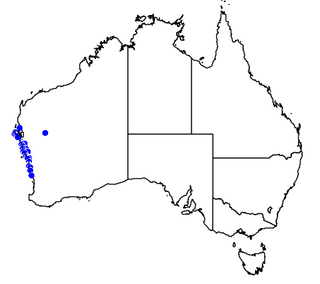
Commersonia borealis is a species of flowering plant in the family Malvaceae and is endemic to the southwest of Western Australia. It is a low growing, spreading shrub with egg-shaped to oblong leaves, and white, yellow and cream-coloured flowers.
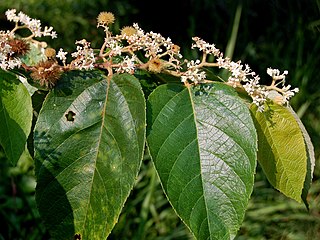
Commersonia bartramia, commonly known as brown kurrajong, is a species of flowering plant in the family Malvaceae and is native to Southeast Asia, the Northern Territory, Queensland and New South Wales. It is a tree or shrub with heart-shaped to egg-shaped leaves much paler on the lower surface, and sometimes with fine, irregular teeth on the edges.

Commersonia amystia is a species of flowering plant in the family Malvaceae and endemic to eastern Australia. It is a dwarf shrub with narrow egg-shaped leaves that are densely covered with star-like hairs on the lower surface, and has flowers with five white sepals that turn pink as they age, and five smaller white petals.

Commersonia craurophylla, commonly known as brittle leaved rulingia, is a species of flowering plant in the family Malvaceae and endemic to southern continental Australia. It is a dense, spreading shrub with crinkled, narrowly oblong to linear leaves, and white to cream-coloured flowers.
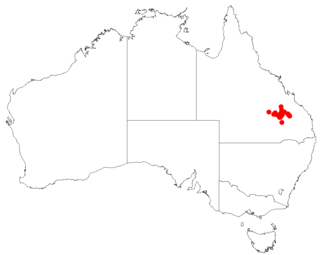
Leucopogon grandiflorus is a species of flowering plant in the heath family Ericaceae and is endemic to Carnarvon National Park in south-eastern Queensland. It is a shrub with softly-hairy branchlets, oblong leaves and white flowers.
Sannantha angusta is a species of flowering plant in the family Myrtaceae, and is endemic to eastern Australia. It has scaly to fibrous bark, narrowly lance-shaped to linear leaves and white flowers, and usually grows in forest on rocky hillsides. It was previously known as Babingtonia angusta, and has been cultivated as Baeckea sp. 'Clarence River'.
Androcalva cuneata is a species of flowering plant in the family Malvaceae and is endemic to the south-west of Western Australia. It is a low, spreading, densely hairy shrub that sometimes forms suckers and has wedge-shaped leaves and clusters of 5 to 15 pink flowers.

Androcalva loxophylla is a species of flowering plant in the family Malvaceae and is endemic to northern Australia. It is a shrub with spreading or low-lying branches, oblong to broadly elliptic leaves and clusters of 4 to 20 yellow flowers.

Androcalva procumbens is a species of flowering plant in the family Malvaceae and is endemic to central New South Wales. It is a prostrate shrub covered with star-shaped hairs, and with slender, trailing stems, egg-shaped to narrowly egg-shaped or lance-shaped leaves with scalloped or lobed edges, and clusters of 4 to 10 white, pink and yellow flowers.

Commersonia magniflora is a species of flowering plant in the family Malvaceae and endemic to Australia. It is an erect shrub with wrinkled, narrowly oblong to elliptic or egg-shaped leaves, and deep pink flowers.
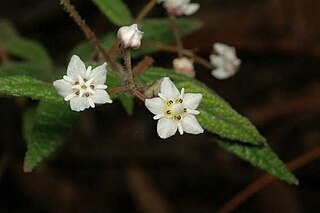
Commersonia rugosa is a species of flowering plant in the family Malvaceae and endemic to New South Wales. It is an open, straggly shrub with linear to narrowly egg-shaped leaves with irregular teeth or lobes on the edges, and white flowers in clusters of 3 to 15.
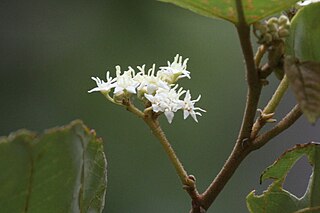
Commersonia macrostipulata is a species of flowering plant in the family Malvaceae and is endemic to Queensland. It is a shrub or tree with egg-shaped leaves that are slightly serrated on the edges, flowers with five cream-coloured to white sepals and bristly fruit.
Commersonia obliqua is a species of flowering plant in the family Malvaceae and is endemic to Vanuatu. It is a shrub or tree with lance-shaped leaves and white flowers.
Androcalva adenothalia is a species of flowering plant in the family Malvaceae and is endemic to the south-west of Western Australia. It is a prostrate shrub with hairy stems, broadly egg-shaped leaves with rounded teeth on the edges, and clusters of 4 to 9 or more white flowers.
Androcalva argentea is a species of flowering plant in the family Malvaceae and is endemic to Queensland. It is a tall shrub that forms suckers from rhizomes and has silvery branchlets and leaves, the leaves egg-shaped with wavy edges and serrated, and dense clusters of 10 to 30 white to cream-coloured flowers.
Androcalva beeronensis is a species of flowering plant in the family Malvaceae and is endemic to Queensland. It is a shrub that forms suckers from rhizomes and has branchlets and leaves covered with soft, golden hairs, the leaves egg-shaped to lance-shaped with toothed edges, and clusters of 9 to 24 cream-coloured to white flowers.

Androcalva crispa, coomonly known as crisped leaf commersonia, is a species of flowering plant in the family Malvaceae and is endemic to the south-west of Western Australia. It is a prostrate shrub that forms suckers from rhizomes and has densely new growth, clusters of lobed, egg-shaped or oblong leaves with wavy, serrated edges, and groups of white and pinkish-purple flowers.
Androcalva incilis is a species of flowering plant in the family Malvaceae and is endemic to the south-west of Western Australia. It is a prostrate shrub with dark green, narrowly wedge-shaped to narrowly oblong leaves, and crowded heads of 8 to 12 deep pink flowers.
Androcalva inglewoodensis is a species of flowering plant in the family Malvaceae and is endemic to south-eastern Queensland. It is a spreading, prostrate shrub that has hairy young branchlets, egg-shaped to elliptic leaves with irregularly serrated edges, and small groups of white to cream-coloured flowers.












